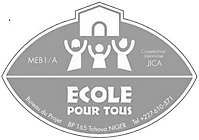Japan's Official Development Assistance White Paper 2007
Column 3 Remaking Every Elementary School into a "School for All"
— Applying Japan's Assistance Models to 9,000 Schools in Niger —
The logo shown below is for the "Ecole Pour Tous (School for All)" project. The logo design was contested by students from 1,300 elementary schools in the Tahoua Region. Among many entries, the one proposed by Oussina, a sixth-grade girl, was adopted, which was then redesigned into a logo. The concept of the design is "the eye representing knowledge and the school supported by all." The logo symbolizes the people's expectation and the basic philosophy of this project.

With two-thirds of its land area covered by Saharan desert, Niger is one of the poorest nations in Africa. Life expectancy is 44.6 years, and people living on less than $2 per day make up 85.8% of the country's population. Given this situation, educating children who forge the future is the key to the country's development. Nevertheless, parents engaged in a daily struggle for survival have no time to think in this way. In rural areas, schools are considered as "alien" institutions that teach things that have nothing to do with village life.
To promote understanding of schools, the government of Niger established a school management committee. The committee was intended to encourage participation by parents, but met with little success, prompting the government to ask for cooperation from Japan. From there, the "School for All" project started in 2004.
Masahiro Hara, the JICA expert working as the Chief Advisor on this project, introduced an innovative method: selection of the members of the school management committee through democratic election. Hara looks back at that moment: "There was opposition as some doubted the efficacy of holding elections in the traditional rural villages with low literacy rates.* But I was absolutely confident that they could do it. I organized study sessions for the school principals, who managed the election, to enable them to transmit the importance of choosing members who would listen to the entire community and all parents to reflect their opinions on the school management. As result, elections were carried out in almost all villages. Until then, there had been some cases in which influential people in the village became members or illiterate persons acted as secretaries or treasurers. Now, by choosing their representatives by themselves, the people got more familiar with the school management committee, which became a sort of bridge between the schools and the parents."
Furthermore, Hara introduced a "school activity program" to back the parents managing schools on a continuous basis. Under the program, the people take initiative to find out and think about the problems concerning schools and to discuss solutions and budget allocations. Hara also proposed a system of making the residents pay fees and contribute necessary materials and labor. The program grew to incorporate various activities such as the construction of temporary classrooms, toilets, and walls, as well as purchase of teaching materials, region-specific curriculum that incorporates handicrafts and agriculture, and a promotional tour to improve attendance. Later, study sessions were organized to introduce the project to other schools. To ensure that all people can understand, some study sessions were effectively explained with simulations such as short plays.
The government of Niger recognized the effectiveness and feasibility of applying Japan's assistance model to the entire nation, as it was easy to understand, cost effective, and responsive to local needs, which help the people take initiative themselves. As a result, Niger decided to apply Japan's model to its 9,000 elementary schools using finance from the World Bank. Other countries and international organizations, too, have been working on programs to promote residents' participation in the decision-making process, but there was a challenge of cost and immediate effectiveness, since their method was to spend money and time on one village. The Japanese model addressed that challenge by introducing a unique method.
The idea expressed in Oussina's logo is now becoming a nationwide reality. Hara sees that the success of the "School for All" owes to the power of the community. He explains, "The need for education and the motivation and capability to change the status quo are inherent in every individual, and in every community, like groundwater. This project worked as a pump to draw such water from a well." The project continues today, in the form of technical support for training and school monitoring. It is there to support the innate potential of the people.

Oussina (right) and Chief Advisor Hara (left)
(Pictured, center, is the principal of the school attended by Oussina) (Photo: JICA)


 Next Page
Next Page